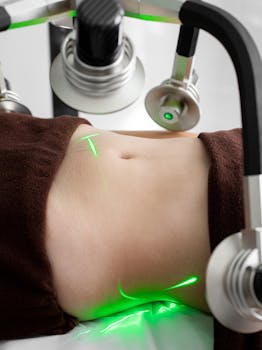Many people explore non surgical abdominal fat removal as a way to address stubborn belly fat without going under the knife. If you’re curious about lower belly fat removal, non invasive fat reduction options like cryolipolysis, radiofrequency, and focused ultrasound can seem appealing. This article walks through how these treatments work, who they help most, typical results, risks, and what to expect from recovery so you can make an informed choice.
Non-surgical abdominal fat removal options
“Non-surgical abdominal fat removal” is an umbrella term that covers several non invasive fat reduction procedures. Common approaches include cryolipolysis (fat freezing), low-level laser therapy, high-intensity focused ultrasound (HIFU), and radiofrequency devices that heat tissue to reduce fat and tighten skin. These treatments are often marketed as non surgical lipo alternatives for people who want body contouring without incisions, anesthesia, or long downtime.
How the main treatments work
- Cryolipolysis: Targets fat cells with controlled cooling to trigger gradual cell removal by the body’s immune system. It’s widely used for the abdomen and flanks. See more about the science behind fat freezing on Wikipedia: Cryolipolysis.
- Ultrasound and HIFU: Use focused sound waves to disrupt fat cells, sometimes combined with collagen remodeling for skin tightening.
- Radiofrequency (RF): Heats deeper tissue to reduce fat volume and stimulate collagen for firmer skin.
- Laser-based therapies: Employ heat or low-level lasers to fragment fat cells and encourage removal by the lymphatic system.
Who is a good candidate?
Non invasive fat reduction procedures work best for people near their ideal weight who have localized pockets of fat—such as lower belly fat removal needs—rather than generalized obesity. Candidates should have realistic expectations: these treatments reduce small to moderate bulges and improve contour, but they’re not a replacement for weight loss through diet and exercise. People seeking non surgical fupa removal (fat under the belly button area) often see meaningful contouring, but results depend on fat thickness, skin elasticity, and individual response.
Pros: Why people choose these treatments
- No general anesthesia and no surgical incisions.
- Minimal downtime—most patients return to normal activities the same day or within a few days.
- Lower immediate risk profile compared with surgical lipo.
- Gradual, natural-looking fat reduction in targeted areas.
Cons and limitations
There are trade-offs. Non surgical lipo techniques generally produce milder reductions than traditional liposuction and may require multiple sessions. Some people experience temporary numbness, bruising, swelling, or soreness. Rare side effects include paradoxical adipose hyperplasia (an increase in fat volume after cryolipolysis) and uneven contours if treatment planning is poor. Costs can add up when multiple areas or repeat visits are needed. Discuss medical history and realistic goals with a licensed provider before committing.
What results and timeline can you expect?
Results are gradual. After treatments like fat freezing or HIFU, you may start to notice changes in 4–8 weeks, with final results often visible after 3 months as your body clears treated fat cells. For some modalities, multiple sessions spaced weeks apart improve the outcome. Keep in mind that long-term maintenance depends on lifestyle; treated fat cells are removed, but remaining cells can expand with weight gain.
If you’re improving overall appearance and skin health, consider pairing contouring treatments with a broader skincare and wellness routine. For practical skin-care tips and technology updates that complement body treatments, this resource on the latest breakthroughs in skincare technology is helpful: transform your routine with new skincare technology.
Costs, safety, and selecting a provider
Prices vary widely by region, clinic, and device. Ask providers about the exact technology, how many sessions they recommend, expected outcomes, and before-and-after photos for similar body-types. Ensure treatments are performed by or under the supervision of credentialed clinicians in an accredited facility. Verify post-treatment follow-up and ask about potential complications so you feel comfortable with the plan.
- Recovery is typically quick; however, avoid intense exercise for a short period if your provider recommends it.
- Pregnancy, certain medical conditions, and implanted devices may disqualify you—always disclose your full medical history.
- Takeaways:
- Non surgical abdominal fat removal offers non invasive fat reduction for localized bulges but is not a weight-loss solution.
- Multiple technologies exist—cryolipolysis, ultrasound, RF, and lasers—each with pros and cons.
- Expect gradual results over weeks to months; realistic goals and the right provider are key.
Is non surgical abdominal fat removal permanent?
Treated fat cells are typically eliminated and don’t return; however, remaining fat cells can grow with weight gain. Long-term maintenance through diet and exercise is necessary to preserve results.
How many sessions will I need?
The number of sessions depends on the technology, the size of the treated area, and your goals. Many people need one to three sessions per area; your clinician should provide a personalized plan and expected timeline.






